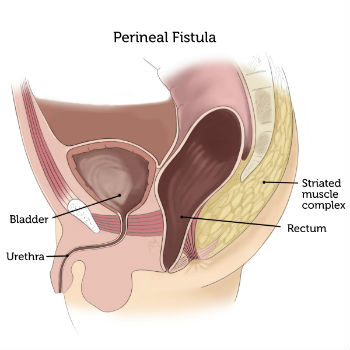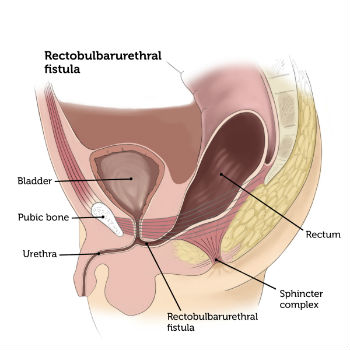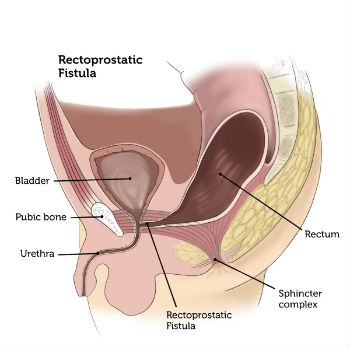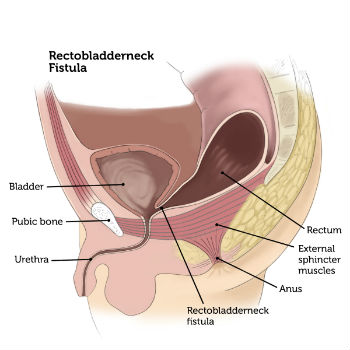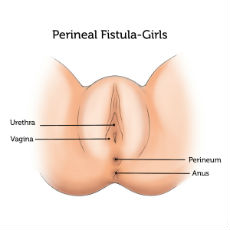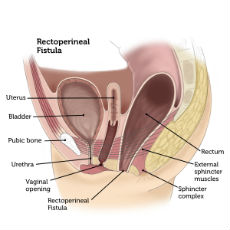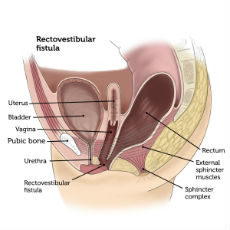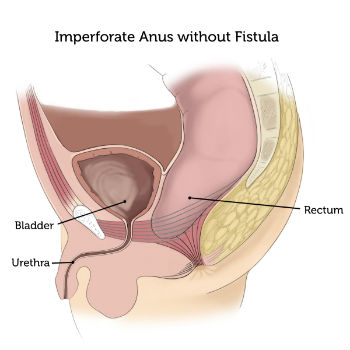Anorectal Malformation | Symptoms & Causes
What are the symptoms of an anorectal malformation?
Anorectal malformations such as imperforate anus cause abnormalities in the way a baby has a bowel movement. These problems vary depending on the type of malformation:
- If the anal passage is narrow, your baby may have a difficult time passing a stool, causing constipation and possibly discomfort.
- If there is a membrane over the anal opening, your baby may be unable to have a bowel movement.
- If the rectum is not connected to the anus but there is a fistula present, stool will leave your baby's body through the fistula and enter the urinary tract instead of the anus. This can cause urinary infection.
- If the rectum is not connected to the anus and there is not a fistula present, there is no way for the stool to leave the intestine. Then, your baby will be unable to have a bowel movement and will have a blockage of the intestine as a newborn.
What causes anorectal malformations?
As a fetus is growing in its mother's uterus, all organ systems are developing and maturing at different rates. Certain steps have to take place in the seventh to tenth weeks of gestation for the rectum and anus to separate from the urinary tract and form properly. Sometimes these steps do not occur as they should, and the rectum, anus or both may not develop normally.
Most of the time, the cause for an anorectal malformation is unknown, but in rare cases, it appears to run in families. Boys are at a slightly higher risk for this abnormality than girls.
Up to one third of babies who have genetic syndromes, chromosomal abnormalities or other congenital defects also have imperforate anus or other anorectal malformations. These genetic syndromes and other congenital problems include:
- VACTERL association (a syndrome in which there are vertebral, anal, cardiac, tracheal, esophageal, renal and limb abnormalities)
- Digestive system abnormalities
- Urinary tract abnormalities
- Abnormalities of the spine
Anorectal Malformation | Diagnosis & Treatments
How are anorectal malformations diagnosed?
Your baby's physician will perform a physical examination when your baby is born, and will look at the anus to see if it is open and in the proper position. If the doctor suspects an anorectal malformation, he or she may order diagnostic imaging to get more details on the severity of the problem:
- Abdominal X-ray
- Abdominal ultrasound (sonography)

How are anorectal malformations treated?
The majority of babies with anorectal malformations will need to have surgery to correct the problem. The type and number of operations necessary depends on the type and extent of the abnormality.
Narrow anal passage
Babies who have the type of malformation that causes the anal passage to be narrow may not need an operation. A procedure known as anal dilatation may be done periodically to help stretch the anal muscles so stool can pass through it easily. However, if the anal opening is positioned incorrectly, an operation may be needed to relocate it.
Anal membrane
Babies with this type of malformation will need to have the membrane removed during surgery. Anal dilatations may need to be done afterward to help prevent narrowing of the anal passage.
How we care for anorectal malformations
Anorectal malformations can be complex issues. The Colorectal and Pelvic Malformation Center at Boston Children’s Hospital includes a comprehensive team of colorectal surgeons, urologists, gynecologists and gastroenterologists who evaluate the problem using advanced diagnostic tests and then provide a coordinated plan of care for children with anorectal malformations such as imperforate anus. Because the surgery is only the first step for many of these children, the center not only offers reconstructive surgical care, but lifelong management of bowel, bladder and reproductive issues as well.
We offer therapies that are limited to only a few centers around the world, such as:
- Bowel management program
- Peristeen counseling
- Sacral nerve stimulation
Our team also includes nutritionists, psychologists, and other experts to improve the quality of life for each child entrusted to our care.

